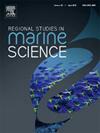First assessment of anthropogenic marine debris (AMD) in the mangroves of Andaman and Nicobar archipelago, Bay of Bengal
IF 2.1
4区 环境科学与生态学
Q3 ECOLOGY
引用次数: 0
Abstract
We assessed the status of anthropogenic marine debris (AMD) in the mangrove forests of South Andaman Island, Bay of Bengal, which harbors 50 % of the world's true mangrove species. Surveys were conducted across 20 mangrove sites using 1 × 1 m quadrats, covering an area of 1000 m². A total of 6732 debris items, including plastics and non-plastics, were recorded during the surveys. Plastics constituted 68.82 % of the debris, dominated by PET bottles (18.16 %), while non-plastic debris, primarily Tetra packs (18.06 %), glass bottles and beverage cans, contributed 31.18 %. Based on the International Coastal Cleanup classification, land-based sources accounted for 81.52 % of the debris, followed by sea-based (10.09 %) and mixed sources (8.39 %). Carbyn Cove exhibited the highest debris abundance (2162 items) among the twenty sites. The mean debris density was 23.4 items/m², ranging from 135.1 items/m² at Carbyn Cove to 5.9 items/m² at Panighat. Principal Component Analysis revealed patterns linked to local tourism & urbanization, and K-means clustering highlighted associations between debris types and locations. The highest abundance of AMD in Carbyn Cove mangroves and its proximity to coastal settlements and tourist beaches revealed the urgent need to strengthen awareness of solid waste disposal in the marine environment. This baseline study highlights the pressing need for ongoing debris removal initiatives and community awareness regarding waste disposal to avert the long-term accumulation of AMD in mangroves. The findings offer essential insights for policymakers and resource managers to formulate effective solid waste management strategies in the Andaman and Nicobar Islands mangrove ecosystems.
求助全文
约1分钟内获得全文
求助全文
来源期刊

Regional Studies in Marine Science
Agricultural and Biological Sciences-Ecology, Evolution, Behavior and Systematics
CiteScore
3.90
自引率
4.80%
发文量
336
审稿时长
69 days
期刊介绍:
REGIONAL STUDIES IN MARINE SCIENCE will publish scientifically sound papers on regional aspects of maritime and marine resources in estuaries, coastal zones, continental shelf, the seas and oceans.
 求助内容:
求助内容: 应助结果提醒方式:
应助结果提醒方式:


